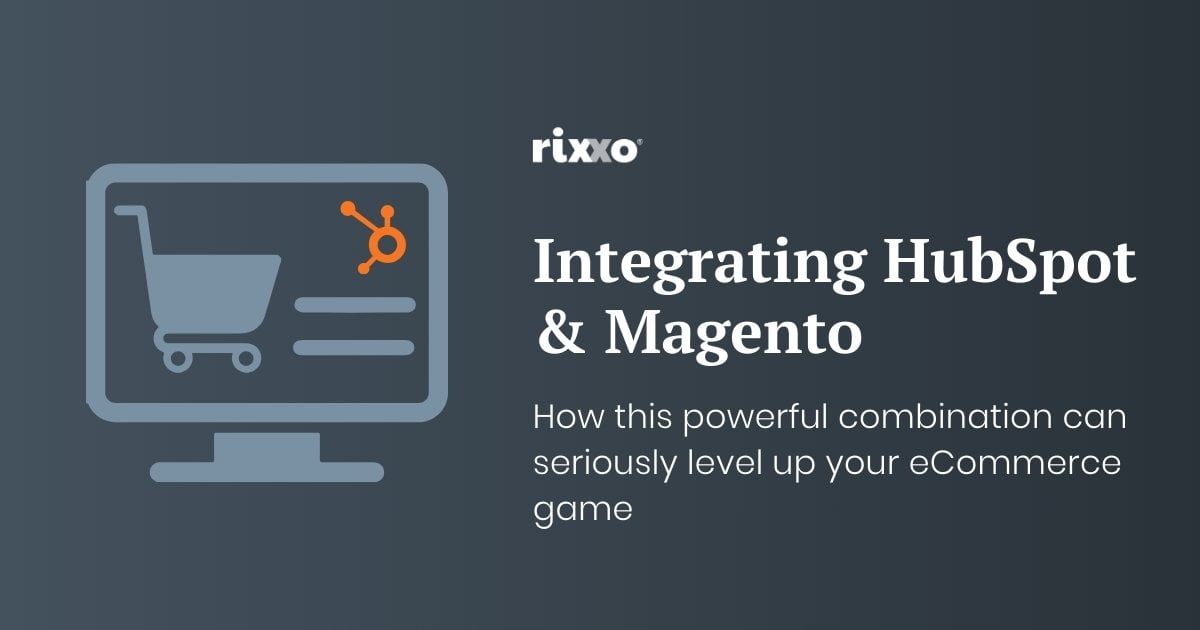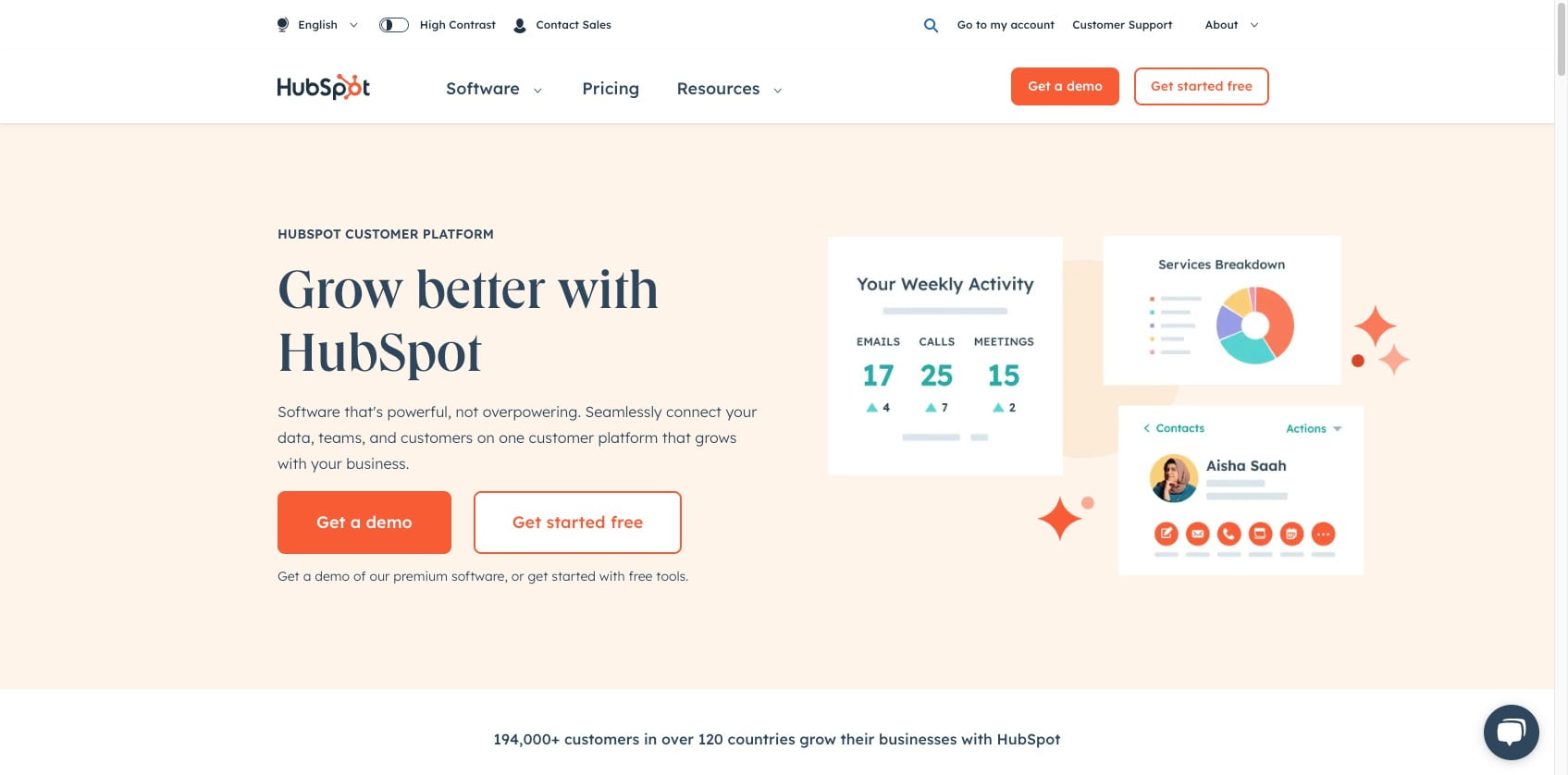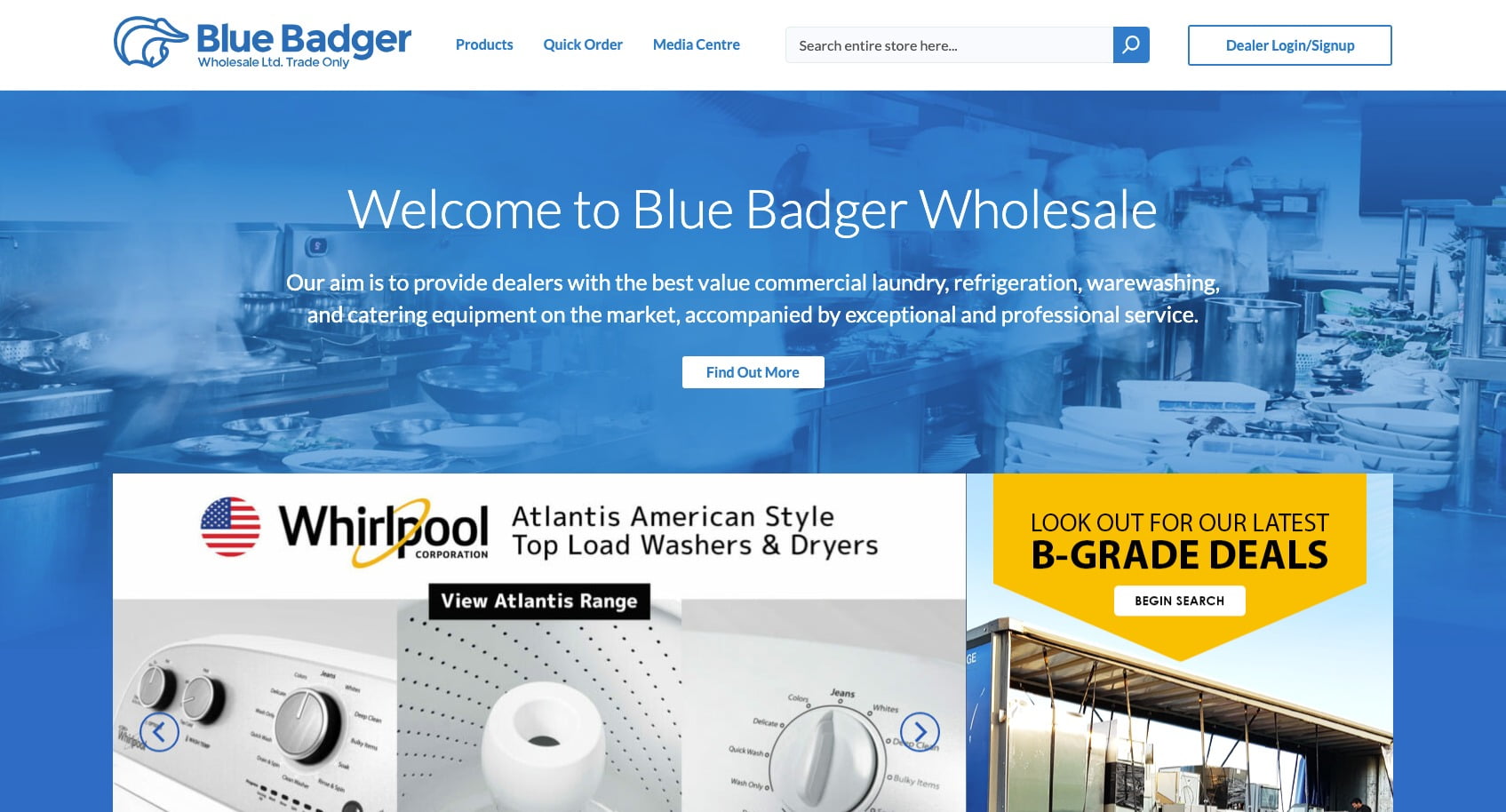HubSpot and Magento Integration: A Complete Guide for eCommerce

An Introduction to Magento & Hubspot
When it comes to tech, we live in a world of almost infinite choice. For an eCommerce business today this is both amazing and daunting in equal measure. After all, the platform and tools you choose will significantly impact the level of success you reach for your business, so it’s a choice that you need to consider carefully.
As an eCommerce agency, specialising in B2B, we’ve worked with just about every eCommerce platform available and we’ve completed eCommerce platform integrations for the biggest and best digital marketing and CRM tools in the game. Which is to say, when it comes to software selection, we know a thing or two. Two names that stand out time and time again for us are Magento and HubSpot.
Magento
Renowned for its incredibly robust and flexible eCommerce platform, Magento offers businesses levels of scalability and customisability that ensure you’ll never outgrow the platform and it’ll never hold you back. Its open-source nature and extensive feature set make it a favourite among eCommerce businesses of all sizes.
HubSpot


Hubspot is a global leader in the digital marketing arena. Known for its comprehensive suite of marketing, sales, and service software, HubSpot excels in streamlining customer relationship management (CRM), automating marketing efforts, and providing invaluable analytics.
Its user-friendly interface and powerful suite of tools make it a valuable asset for businesses looking to enhance their digital marketing strategies, nurture customer relationships and seriously level up their eCommerce game.
The combination of Magento’s power and scalability, with HubSpot’s marketing prowess creates a synergistic relationship that truly empowers businesses, by simplifying complex processes and boosting customer engagement and sales, all while enabling data-driven decision-making.
In this article, we’ll explore how Magento and HubSpot together can level up the way your eCommerce business operates, setting you up for success in a competitive landscape.
Understanding HubSpot: A comprehensive tool for eCommerce growth
If you’ve spent time in the digital marketing space, you’ll probably have heard about HubSpot. And for good reason, HubSpot is one of the most versatile and comprehensive tools around. Known for its exceptional capabilities in customer relationship management (CRM), marketing automation, sales enablement, and customer service. Let’s look at what makes HubSpot an indispensable asset for eCommerce businesses, particularly for those using Magento:


At its core, HubSpot’s CRM system is designed to offer a 360-degree view of customer interactions. This includes tracking customer communications, purchases, and engagement across various channels. For Magento store owners, this means having a centralised repository of customer data that is both accessible and actionable, enabling personalised marketing and sales efforts.
Marketing automation:
HubSpot excels in automating marketing processes, from email campaigns to social media management. This automation extends to lead nurturing, segmentation, and analytics, ensuring that marketing efforts are not only super efficient but also data-driven. For a Magento store, integrating with HubSpot means being able to deploy targeted marketing campaigns that resonate with specific customer segments, leading to increased engagement and conversions.
Sales tools:
HubSpot provides a suite of sales tools designed to streamline the sales process, including features like email tracking, meeting scheduling, and pipeline management. For Magento stores, this translates to enhanced sales efficiency, with a more streamlined approach to managing leads, following up on prospects, and closing deals.
Customer service features:
With HubSpot, customer service goes beyond mere interaction; it becomes a strategic part of the business. Features like ticketing, live chat, and feedback surveys help Magento store owners manage customer issues effectively and gather valuable feedback to improve products and services.
Complementing Magento:
When integrated with Magento, HubSpot becomes a powerful ally in your business. Its marketing and CRM capabilities dovetail perfectly with Magento’s eCommerce strengths, creating a unified platform for managing customer journeys. This integration means Magento store owners can leverage HubSpot’s marketing automation to drive traffic to their store, use CRM data to personalise the shopping experience and employ sales tools to efficiently convert leads into customers. Additionally, the customer service features of HubSpot ensure that after-sales support is as strong as the initial marketing and sales efforts, fostering customer loyalty and repeat business.
The advantages of integrating Magento with HubSpot for eCommerce
Integrating Hubspot into your Magento store gives you a multitude of advantages over your competitors. Let’s explore them now:
Enhanced customer insights: With HubSpot’s advanced CRM capabilities, store owners can gain a deeper understanding of their customers, providing a comprehensive view of customer interactions, preferences, and history, enabling personalised marketing and sales strategies.
Streamlined marketing efforts: When integrated with Magento, HubSpot’s marketing automation tools facilitate super-efficient and targeted marketing campaigns. Your marketing becomes more effective and less time-consuming, freeing up resources to focus on innovation.
Data-driven decision-making: Combining Magento’s rich eCommerce data with HubSpot’s analytics tools provides powerful insights, empowering store owners to make informed decisions about product offerings, marketing strategies, and customer engagement tactics.
Improved sales conversion: By leveraging HubSpot’s tools for lead generation and nurturing within the Magento environment, businesses can more effectively convert visitors into customers and one-time buyers into loyal clients.
Personalised customer experiences: Utilising HubSpot’s personalisation features alongside Magento’s flexible platform allows for tailored customer experiences. From customised product recommendations to personalised email campaigns, this integration makes each customer feel valued and understood.
Automated workflow and efficiency: Automating manual processes, from customer data management to marketing campaign execution helps you save time, eliminate errors and boost your operational efficiency.
Increased customer retention: With HubSpot’s suite of customer service tools, Magento store owners can provide top-notch customer support and service. This level of customer care increases satisfaction and loyalty, encouraging repeat business.
Scalability and flexibility: As your business grows, the combined power of Magento and HubSpot scales with you. This flexibility ensures that the tools and processes you rely on today will continue to support you as your business evolves.
With Magento and HubSpot, store owners can unlock new potential in eCommerce efficiency, customer engagement, and business growth. The integration becomes much more than simply two platforms combined; it’s about creating a cohesive, powerful ecosystem that drives success in the competitive world of eCommerce.
What’s needed for a successful Hubspot and Magento integration?
To ensure a successful integration, some specific technical requirements and steps need to be followed. Here’s a breakdown of what’s required:
Technical requirements and steps
API keys: The integration process begins with the use of API keys. These keys are essential for establishing a secure connection between Magento and HubSpot. You’ll need to generate an API key in HubSpot using a “Private App” and then enter this key in the Magento integration settings.
Private apps allow you to use HubSpot’s APIs to access specific data from your HubSpot account. You can authorise what each private app can request or change in your account, which will generate an access token that’s unique to your app.
Source: Private apps
Choosing the right plugin/module: Several plugins or modules are available for integrating Magento with HubSpot. It’s important to choose one that is compatible with your version of Magento and meets your specific needs. Some popular options include the official HubSpot eCommerce Bridge or third-party connectors available on the Magento Marketplace.
Plugin/module installation: Once the right tool is selected, the next step is to install it. This typically involves downloading the integration module and installing it into your Magento store, followed by a configuration process within your Magento admin panel.
Useful to know: because modules are for general use, they might not fit every Magento install. So depending on your existing levels of customisation, you might need a bespoke solution (see the case study further down as a working example of this exact scenario).
Data syncing processes: After installation, you need to set up the data syncing process. This involves configuring what data (such as customer details, order information, and product data) will be synced from Magento to HubSpot and how frequently this sync will occur.
Testing the integration: Before going live, it’s crucial to test the integration to ensure that data flows correctly between Magento and HubSpot. This testing phase helps identify and rectify any issues, ensuring a smooth operation post-launch.
Importance of Data Mapping and Consistency
- Data mapping: Data mapping is the process of matching fields in Magento to corresponding fields in HubSpot. Correct data mapping is crucial to ensure that the data synced is accurate and meaningful. For example, mapping customer email addresses in Magento to the email field in HubSpot ensures that communication is correctly targeted.
- Ensuring data consistency: Consistency in data between Magento and HubSpot is vital for accurate reporting, segmentation, and personalised marketing. Inconsistencies can lead to misinformed decisions and ineffective marketing strategies. Regular checks and audits of the data are recommended to maintain consistency.
- Custom field considerations: If you use custom fields in Magento, it’s important to understand how these can be mapped to HubSpot. Some fields may require custom solutions to ensure they are accurately represented and utilised within HubSpot.
- Ongoing maintenance: Post-integration, ongoing maintenance is key. Regularly updating the integration tools, monitoring data sync processes, and adapting to any changes in either platform will ensure the integration remains effective and efficient.
A smooth, successful integration of HubSpot with Magento requires careful planning, attention to technical details, and an understanding of data mapping and consistency.
Integration best practises
For any software integration project, there are industry-recognised best practices to follow that ensure a trouble-free implementation. Here are our key tips and suggestions:
Customer data segmentation
- Utilise rich data for detailed segmentation: Leverage the detailed customer data from Magento for in-depth segmentation in HubSpot. Segment customers based on their purchase history, browsing behaviour, and engagement levels to create targeted marketing campaigns.
- Regularly update segments: Customer preferences and behaviours change over time. Regularly review and update your segments to ensure they remain relevant and effective.
Setting Up Automated Workflows
- Align workflows with customer journeys: Design automated workflows in HubSpot that align with the different stages of the customer journey in Magento. For example, set up a welcome email sequence for new customers and re-engagement campaigns for those who haven’t purchased in a while.
- Personalise automation: Use the data from Magento to personalise automated emails and content. Personalisation can significantly increase engagement and conversion rates.
Regularly updating and maintaining the integration
- Schedule regular checks: Regularly check the integration to ensure data is syncing correctly and there are no disruptions in workflows.
- Stay updated with platform changes: Both Magento and HubSpot frequently update their platforms. Stay informed about these changes and how they might affect the integration.
By following these best practices, and with good planning, you can avoid common pitfalls and ensure you get the most benefit from the integration.
CTA: We’re experts at integrating Hubspot with Magento. Get in touch to find out whether a Hubspot integration would be a good fit for your eCommerce business.
Potential challenges and solutions
Like any complex technical endeavour, software integration can present challenges. Being aware of these potential issues and knowing in advance how to address them is key to a smooth and successful project. Let’s explore some common challenges and their practical solutions:
Data syncing issues
- Issue: Inconsistencies or delays in data syncing between Magento and HubSpot can lead to outdated or incorrect information being used in marketing campaigns or sales efforts.
- Solution: Regularly monitor the data sync process. Ensure that the API connections are functioning correctly and check for any errors or alerts. If issues persist, consider consulting with a specialist or reaching out to the support teams of either platform for assistance.
Complex custom fields
- Issue: Custom fields in Magento may not always seamlessly map to HubSpot, leading to missing or incorrectly formatted data.
- Solution: Regularly review and update your data mapping settings. For complex fields, consider creating custom fields in HubSpot to ensure a correct match. If needed, custom development work might be necessary to ensure seamless integration of these fields.
Changing platform features
- Issue: Both Magento and HubSpot frequently update their features and interfaces, which can sometimes disrupt existing integrations.
- Solution: Stay informed about updates from both platforms. Regularly test the integration after any major updates and adjust settings or workflows as necessary. Subscribe to update notifications from both Magento and HubSpot to stay ahead of changes.
Scaling issues
- Issue: As your business grows, the initial setup of your integration might not be able to handle increased data volumes or the complexity of new business processes.
- Solution: Plan for scalability from the start. Regularly assess the performance of the integration and be prepared to upgrade your plan or adjust your workflows to accommodate business growth. Consulting with integration specialists can provide insights into best practices for scalability.
Database update issues
- Issue: Some integrations update directly via the database and do not trigger the functions in off-the-shelf modules.
- Solution: Implement regular synchronisations on a set timer or develop custom solutions that actively monitor these integrations. Regularly scheduled syncs ensure that the data remains up-to-date, even if the standard module functions are not triggered by direct database updates.
Training and Adoption
- Issue: Staff may find it challenging to adapt to the new integrated system, leading to underutilisation or incorrect use of the platforms.
- Solution: Invest in comprehensive training for your team. Ensure they understand how to use both platforms individually and how they interact. Regular training sessions and the creation of user guides can facilitate smoother adoption.
Security and Compliance
- Issue: Handling customer data across two platforms raises concerns regarding data security and compliance with regulations like GDPR.
- Solution: Ensure that both your Magento and HubSpot setups are compliant with data protection laws. Regularly review your data handling and storage practices and consider consulting with a legal expert to ensure compliance.
In summary, while challenges in integrating HubSpot with Magento are inevitable, they can be managed with proactive monitoring, regular updates, training, and a willingness to seek expert advice. Addressing these challenges promptly ensures that your integration continues to serve as a robust tool for enhancing your eCommerce operations.


Need a helping hand?
Whether you have questions, or you'd love to offload your HubSpot and Magento integration to experts who've done this before, click the button to reach out for a chat.
Case study: Blue Badger’s Hubspot integration with Magento


Blue Badger, a leading B2B supplier of commercial catering and laundry equipment, since 2007 makes buying appliances easy for businesses and wholesalers. Their goal is to provide top-quality catering equipment at great prices.
The brief
Blue Badger wanted all stock, product, order and customer information to be available inside HubSpot, so the sales and support teams could better serve their customers.
The challenge
Blue Badger had a lot of customisations in both their Magento Store and their HubSpot CRM tool. In addition, we discovered that their stock data was being updated in a non-standard way that bypassed the normal triggers in Magento.
The solution
Rixxo built a bespoke integration to allow data flow between Blue Badger’s Magento store and HubSpot. This included:
- A company and customer Hubspot integration
- An order/deal integration
- A product integration
- A stock integration
Results
The customer service team can quickly and easily track down customer orders, including historical orders, without needing detailed information.
Sales teams can view a customer’s order history, helping them understand and meet the customer’s needs more effectively.
Quotes sent out now include specific products and pricing, all updated with the latest information.
Key Takeaway
Magento is a great content management system (CMS) but falls short as a customer relationship management (CRM) tool. It’s not the easiest for everyday staff use.
On the other hand, Hubspot is an outstanding CRM, packed with features that help team members excel in their roles. By merging Magento’s information with Hubspot’s tools and capabilities, Blue Badger’s team now enjoys the best of both worlds. This integration gives them a deeper insight into their customers’ needs.
A final word on Hubspot and Magento integration
Integrating HubSpot with your Magento store represents a smart, strategic step to level up your eCommerce game. This powerful combination brings together the best of both worlds: Magento’s robust eCommerce platform with HubSpot’s advanced CRM and marketing automation tools.
Here are the key takeaways from our exploration of this integration:
Streamlined operations: The integration leads to more efficient processes, from customer data management to marketing and sales workflows, allowing you to focus on growth and innovation.
Personalised customer engagement: Leveraging the combined data of Magento and HubSpot enables highly targeted and personalised marketing campaigns, significantly improving customer engagement and satisfaction.
Data-driven strategies: The integration provides valuable insights for informed decision-making, allowing you to refine product offerings, marketing strategies, and customer engagement tactics based on solid data.
Enhanced sales conversion: By utilising HubSpot’s lead generation and nurturing tools within the Magento environment, you can more effectively convert visitors into loyal customers, boosting your sales and revenue.
Automation and efficiency: Automated workflows save time, reduce errors, and ensure a consistent and seamless customer experience, enhancing the overall efficiency of your eCommerce operations.
Scalability and flexibility: As your business grows, this integration scales with you, offering the flexibility and robustness needed to adapt to changing market demands.
Continuous improvement: Regular updates and maintenance of the integration ensure that you stay ahead of technological advancements and market trends.
The integration of HubSpot with Magento is not just about enhancing individual parts of your business; it’s about transforming your entire eCommerce operation into a more efficient, customer-centric, and data-driven enterprise. If you haven’t yet considered integrating HubSpot with your Magento store, now is the time to explore this opportunity.
